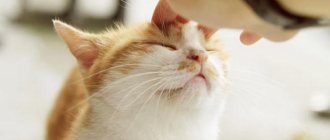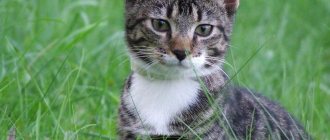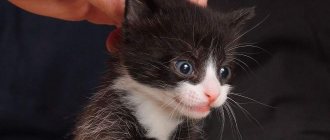Other flavors
In addition to the aforementioned “basic” tastes, cats are able to recognize amino acids.
This feature is characteristic of most large cats in nature. Thanks to it, the cat can determine the type of meat, its fat content, freshness and other important features. They also have water taste receptors. This is why cats often drink water from the tap or from large containers where the water does not stagnate longer. Therefore, try to change the water in your pet's bowl at least twice a day. Remember that cats tend to remember taste for a long time. When choosing food, they are guided by past experiences. Cats quickly establish a connection between the substance they consume and the consequences for the body. Therefore, after eating food that led to eating disorders, the cat will refuse it in the future.
However, a variety of tastes is very important for a cat from childhood.
Source
In what form can a cat eat sweets?
From time to time, animals can be given gifts of nature, which contain natural sugars (fructose/glucose) - fruit, berries and vegetable crops growing in our gardens and orchards. By the way, many cats (especially those relaxing in garden plots) beg for and happily eat pieces of sweet vegetables/fruits.
A storehouse of healthy sugars are ripe and dried fruits, such as:
- apples are not only vitamins/minerals, but also fiber, whose fibers clean your teeth;
- pears – there is also a lot of fiber and minerals/vitamins here;
- apricots, plums - in small quantities;
- melons - give with caution, since watermelon puts a strain on the kidneys, and melon is poorly digested;
- figs, dates and dried apricots - these fruits are given in dried/dried form (rarely);
- raspberries, blueberries, blackberries are also included in the menu if there are no allergic manifestations.
A very attractive natural sweet is honey. But this popular beekeeping product should be handled extremely carefully, adding drops to the food in order to immediately notice an allergic reaction.
Important! Seeds and nuts have a certain sweetness. In this food segment, pay attention to such healthy treats as almonds, sesame seeds (after processing and fresh), sunflower seeds (hulled) and pine nuts.
Along with those listed, other sweet crops are also suitable for cats:
- wheat/oats (sprouted) – these cereals are good for constipation, as they cleanse the intestines of feces;
- new potatoes/yams;
- swede;
- pumpkin;
- carrot;
- parsnip (root);
- turnip;
- beets (as a natural laxative).
Remember that the cat is not stuffed with vegetables, fruits and berries, but is only given a little at a time if she herself shows gastronomic interest in the product. Without a doubt, the animal will benefit greatly from a vitamin crop collected at the owner's own dacha - it does not contain pesticides and other chemicals present in foreign vegetables and fruits. If you have to go to the supermarket, buy domestic agricultural products that have not lost their juiciness.
> Video about the dangers of sweets for cats Tags: cat health, cats, treatment, is it possible to have sweets, recommendations, sweets for cats, tips
Cat's taste buds
There are only a few hundred taste buds in a cat's mouth, which is incomparable to the nine thousand in humans. And at the same time, she will unmistakably distinguish a desired treat from an unloved one. Incredible! It turns out that her sense of smell is much better developed than one would expect.
What motivates an animal when it chooses a treat? Does it rely on smell or taste?
The sense of smell is extremely important in attracting an animal to food. A cat's nose is many times more sensitive than a human's. This is thought to help cats differentiate between tastes.
But representatives of the Feline family have something special - Jacobson's organ of smell. This is part of the nose area, which became isolated during the process of evolution, and is connected to the external environment through small holes in the roof of the mouth behind the front teeth. Meowing pets use it to understand tastes and aromas. Although the function of this olfactory organ is still debated.
At the tip of the tongue, on its underside and on the sides, the cat has taste buds.
And yet, what is the best way to attract your pet to a bowl of food? A big piece is better for him than crumbs. And soft food is preferable to hard food. They say that even the shape matters and it is better if the large pieces are not the same from day to day. Warm food will attract you more quickly than food fresh from the refrigerator.
In addition, these animals remember the taste for a long time. And they will establish the connection between the food eaten and its consequences for the body quite quickly. If some food leads to an upset stomach, the pet will refuse it in the future. And vice versa, what you like will be readily consumed.
Sweets and cat diseases
The first thing that can happen to a pet when eating sweets is a decrease in immunity and the development of many serious diseases.
Immune defense disorders
Even a small piece of chocolate can cause severe poisoning in a cat. And if everything seems to have gone well, the consequences may be distant.
The immune system was damaged in any case. And against the background of this disorder, allergic reactions may occur, diseases of the oral cavity may appear, numerous redness, ulcers and sores form on the gums, itching of the skin, hair loss begins and the development of alopenia.
Chocolate, sweets, and cakes can also cause a deterioration in a cat’s vision, including blindness, as well as cause diarrhea and vomiting, and increased salivation.
Decreased immunity undermines the cat's body's defenses. The animal becomes susceptible to colds and viral diseases, otitis media and conjunctivitis, fungal infections of any organs.
The digestive system also suffers, the animal develops a false feeling of fullness, and the digestibility of animal protein deteriorates. Oxygen saturation of tissues decreases, and the aging process of the entire organism as a whole accelerates.
Urolithiasis disease
Cats' kidneys are the first to suffer when they eat sweets. Due to intensive work (after all, this is a purification system that unsuccessfully tries to remove harmful products from the body), they significantly increase in size.
The animal's organs are subject to wear and tear, and the acid-base balance is disturbed. And sweets can lead to this just as much as salty foods.
Depending on the type of sweets, either excessive oxidation or alkalization of the body occurs, which in any case leads to the development of kidney failure. Urolithiasis, when eating sweets in large quantities, occurs even in cats that do not have a predisposition to it.
Diabetes
A cat's body is not designed to process large amounts of glucose. Insulin begins to be produced in concentrations that greatly exceed the permissible norm in the blood.
The cat quickly loses sensitivity to this substance, the level of glucose in both the blood and the animal’s urine always remains at high levels, diabetes mellitus quickly develops and the pet becomes a hostage to the “sugar” diet.
Excess carbohydrates
A person often eats a piece of chocolate when he needs to quickly increase energy levels, relieve fatigue, improve the ability to think and make decisions instantly, during heavy mental or physical work. And after even a small dose of chocolate, you feel a surge of strength and acceleration of thought.
By offering the same piece of treat to a pet, the owner causes him great harm. Especially for a cat in a small apartment, where she does not have the opportunity to move enough. All excess carbohydrates, even if they do not lead to serious illnesses, will certainly be stored in the form of excess fat.
Nature provides for the consumption of large quantities of proteins by predators, which is the key to their health and longevity. Carbohydrates are needed in minimal quantities; exceeding the required level means dooming your pet to illness and early death.
What tastes does a cat have?
Bitter
Cats have a sharply negative attitude towards this taste. Even in the lowest concentration, it is recognizable and alarming. It's in the genes of meowing pets. It is bitterness that serves as a warning about harmful, even poisonous products or objects. Moreover, there is quite a lot of really poisonous stuff in the house, especially for a small kitten, such an inquisitive and restless one - indoor plants, cheap toys, household chemicals.
We suggest you read: Why does a cat’s ears always have dirty insides?
Humans have long been actively using the ability of pets to avoid bitter taste for educational purposes in the form. Bitter-tasting liquids that do not irritate the skin and mucous membranes can be used even in the area of wounds, bandages and stitches, not to mention spraying furniture, fabrics, etc. With the help of such measures, the animal is weaned from sharpening its claws in the wrong places, and is stopped in the desire to lick wounds. But the bitter pill that must be fed to the animal will force the owner to be inventive.
Sour
Even the pronounced sour taste of cats is extremely attractive. Most meowing pets are very respectful of sour cream and kefir. But the owner should not forget that in large quantities sour foods are harmful to health.
Salty
The cat likes the salty taste. Some even advise adding salt to your animal’s food and drink in moderation. But it should be remembered that after salty food, the animal feels the need to drink frequently.
A group of researchers at the Monel Chemical Senses Center (USA) was looking for an answer to this rather controversial question. The conclusion was unequivocal - cats do not have sweet taste receptors, neither domestic nor wild.
A carnivorous predator, although tame, is forced to eat meat. He doesn’t particularly need sugar and carbohydrates, which means there’s no reason to have the appropriate receptors for sweets either. It turns out that the taste buds of cats, reacting to the meat and fats it contains, drive the animal’s appetite.
Some might argue, especially if their pet enjoys eating candy or ice cream. Most likely, the animal is attracted to the fat contained in these products. And he will find it easily.
Cats do not taste sweetness and do not experience any discomfort from it. By the way, in nature, sweet fruits are not included in the diet of members of the family.
These animals have special receptors with the help of which they distinguish the taste of water and clearly prefer it over other drinks. Some people choose a trickle from the tap rather than a bowl of water. However, the opposite also happens. In any case, the water should not stagnate, so it is better to change it more often.
Taste of meat
This taste has another name - broth. It's close to salty. A special umami receptor quickly recognizes glutamic acid salts in food. This is how a cat distinguishes between types of meat, fat content, and freshness of the product. These salts are found in every animal protein and are also synthesized in the body. By the way, if you add monosodium glutamate to your food, the food will become much more attractive to your cat, even if there is no meat in it. In fairness, it is worth noting that it has the same effect on humans.
Many different studies have been conducted to determine the taste of cats. There are no clear unambiguous answers. But there is certainly a connection between the preferences of a mother and her kitten. The baby will certainly choose the food that his mother cat ate, even if it is cucumbers or bananas.
We suggest you familiarize yourself with: Cats and cats with different eyes breed
Which taste is better
In nature, cats do not crave fruits, honey, or anything sweet, which is why they do not need the ability to recognize sweet tastes. If this worries you, then lightly salted milk buckwheat, rice or oatmeal porridge will be an excellent dessert for a cat, while for you the same porridge only with sugar or honey. And the whole family, together with their feline household, will gobble up this dish on both cheeks, and together you will be healthy and happy.
© shutterstock
Cats should also be given warm food. This is explained by the carnivorous nature of cats. By nature, cats and cats are predators who naturally consume fresh meat. The ideal temperature of cat food should be equal to the temperature of the cat's tongue - 30-35 degrees . The tongue is responsible for the taste of food in cats.
Reasons for the popularity of cats
A century ago, cats were bred mainly to hunt mice and rats. Now, for this purpose, a cat is taken into the house only in 10% of cases. The main reason why people now decide to adopt a kitten is the opportunity to interact with the animal.
According to statistics, the main cat lovers are pensioners over 60 years of age (43%) and single women (36%).
Most pensioners keep cats at home
Interestingly, only 25% of cat owners preferred purebred and rare animals - in this case, when choosing an animal, cat owners are guided not only by the desire to find a friend, but also to confirm their status or start a business selling kittens.
What to give: what sweets can a cat eat?
A more harmless sweet for your pet is melon.
Sometimes veterinarians from the Pride clinic allow you to pamper your pet with sweets. Plant products containing fructose and glucose are ideal for this. They should be added to main dishes in small quantities. An increased concentration of healthy sugars is found in ripe and dried fruits. You can give your cat the following products:
- Apples and pears. They contain vitamins and minerals, as well as fiber, which has a beneficial effect on the gastrointestinal tract and cleanses the oral cavity.
- Apricots and plums. Improves intestinal function and prevents constipation.
- Dried apricots, figs and dates. It is recommended to give dried, in small quantities and very rarely.
- Watermelons and melons. Add to food with caution, in small portions.
If the cat does not have allergic reactions to raspberries, blueberries and blackberries, then you can replenish your pet’s vitamin supply by introducing them into the diet.
For a balanced diet, you can add the following crops to the menu:
Thanks to sprouted wheat, your pet's diet will be more balanced.
- sprouted wheat and oats;
- boiled or baked pumpkin and rutabaga;
- young potatoes, boiled without salt;
- beets and carrots, raw and boiled.
Natural sweetness comes from honey, seeds and nuts. As for the beekeeping product, it should be handled with extreme caution so as not to cause allergic reactions. Nuts such as almonds and sesame are given to the cat in peeled and crushed form. Pets willingly eat sunflower and pumpkin seeds. However, the owner needs to remember that the seeds must be raw and well peeled.
Interesting facts about cats and cats
Pet owners tend to humanize their pets, and this is their big mistake. Domestic cats, despite their long history of living side by side with people, have not lost their special animal habits. They do everything differently, and even hear, see and taste differently than you and I.
The difference between how a person and a cat sees the world around them is obvious
Taste perception
People have 9 thousand receptors on their tongue, but cats have only 473. Our meowing friends distinguish tastes, but their palette will not be as bright as ours, without the ability to distinguish taste “halftones” (for an animal there will be several variations of hot or sour united). The only taste that a cat does not feel at all is sweet. Any sugary dessert for a cat will be tasteless.
A cat may try sweets, but not because of the taste, but because of curiosity or an interesting smell for them
They have little discernment of salty taste, so they will easily eat a very salty dish, and this is unsafe. But cats secrete bitterness better than us - this is a protective mechanism that protects the animal from possible poisoning.
Do cats sweat?
Cats have 10 times fewer sebaceous glands than humans, so they sweat very little. This is due to the fact that cats rarely run for a long time (in their nature they lie in wait for their prey, and do not catch up), moreover, the copious secretion of odorous sweat would prevent them from hunting. If cats need to lower their temperature, they try to lie on a cold surface, use changes in the frequency and depth of breathing, and wet their fur with saliva, which will increase heat transfer.
When overheated, cats can, like dogs, open their mouths and breathe rapidly.
Sphynxes are the only cats that sweat
The cat clearly reacts to certain phrases: he responds to a nickname, knows when he is called to eat or is about to be scolded. Some animals even understand commands (“place” or “fetch”). The most intelligent cats are able to remember the meaning of several dozen words (memorization occurs after 5-6 repetitions, while dogs require 12-15 repetitions).
Cats can remember the meaning of some words and commands, but they still react more to intonation, voice volume, and gestures.
Cats' memory is based on conditioned reflexes, not feelings. The pet will easily remember what resulted in the necessary conditions (delicious food, privacy, encouragement, etc.). But associative connections in the memory of cats must be built quickly: if more than 3-7 minutes have passed between cause and effect, then memorization will not occur.
If a cat is separated from her brothers, sisters, mother and her own kittens for a couple of months, then when she meets them she will not recognize them - all because in nature, family ties are not important for a cat and any other animals become competitors for resources and territory
Cats see well at a distance of 70 cm to 5.5 m. And such farsightedness is justified: a normal mouse will not fit into its mouth on its own, it must be seen from afar. What is important is that a cat is able to concentrate on a specific object; its eyes cannot “bring clarity” to a large-diameter picture.
As for hearing, it is 4 times sharper than that of a person. This is helped by the shape of the auricle and its location like an antenna - even muffled sounds are well caught in such a pointed funnel.
Many white, blue-eyed cats are born hearing impaired or deaf due to a genetic defect.
Play behavior
Games for cats are training of hunting instincts. Favorite entertainment is to track, catch, catch and fight.
Kitten games are preparation for adulthood
The tendency to be playful is largely determined by the breed. For example, Persian, Burmese and ragdoll cats are considered the calmest and most unplayful. Siamese, Abyssinians and Orientals are very active in childhood and will drive their owners crazy with their wild jumps and desire to catch and pat everything around. But most representatives of these breeds practically stop being naughty by the age of two.
We suggest you familiarize yourself with: Hatching chickens in the incubator temperature and timing
Cats and water
Very few cats are calm about water, much less voluntarily agree to take a dip in the bath.
It is believed that of all the breeds, the Bengal shorthair cat is best suited to water procedures.
The cat refuses to bathe because the water pushes out the air gap between the fur and skin. This layer warms the animal, and wet wool, on the contrary, promotes rapid heat transfer. In addition, it is heavy, the cat becomes slower, which means that in case of danger it will be more difficult for it to escape from the enemy.
Why is a cat interested in sweets?
Some four-legged animals are irresistibly drawn to sweets (waffles, cookies or candies), which is, in principle, unnatural. Felines, like typical carnivores, recognize proteins but do not need sugars.
Genes against sweets
The tongue of most mammals is equipped with taste buds that scan the type of food, transmitting this data to the brain. Humans have five receptors that respond to sweet, salty, bitter, sour and umami (the rich taste of high-protein compounds). The receptor responsible for the perception of sweetness is a pair of proteins created by 2 genes (Tas1r2 and Tas1r3).
This is interesting! In 2005, geneticists from the Monell Chemical Senses Center (Philadelphia) found that absolutely all cats (both domestic and wild) do not have the amino acids that form the DNA of the Tas1r2 gene.
In other words, cats lack one of the obligatory genes responsible for identifying sweet taste, which means that tailed animals do not have a taste receptor that gives a reaction to sweets.
Sweet cravings
If your cat begins to beg for sugary treats, such as ice cream, most likely she is attracted by the taste of milk proteins, fats, or some kind of synthetic additives.
The imbalance in gastronomic preferences can also be rationally explained this way:
- the animal is attracted not by taste, but by smell;
- the cat likes the consistency of the product;
- the pet is eager to get a treat from the table/from your hands;
- the cat has vitamin deficiency (lack of minerals/vitamins);
- her diet is not balanced (lots of meat and no carbohydrates).
In the latter case, review the menu to include healthy carbohydrate foods.
Signs associated with cats
According to popular observations, cats intuitively sense change. They say that by observing the behavior of your pet, you can predict the weather, the arrival of guests, an impending illness, a change for the better or misfortune:
- a cat sleeps with its belly up - to the heat;
- the cat curled up into a tight ball - it will soon get colder;
- the cat washes its face all day - wait for guests;
A cat washing itself means the imminent arrival of guests - a cat reaches out to a person - for a new thing;
- a cat rubbing against a person’s ear means an increase in money;
- The cat sneezed three times - someone in the house will get sick.
By the way, it is believed that if a cat lies on a sick person, then it cannot be driven away, since the animal takes the illness upon itself.
It is believed that a red cat in the house attracts money, a black one wards off evil spirits, a white one protects the health of its owners, and a tricolor one is responsible for peace in the family.
What can I do to prevent this in the future?
If you are on a personal connection, like at home, you can run an anti-virus scan on your device to make sure it is not infected with malware.
If you are at an office or shared network, you can ask the network administrator to run a scan across the network looking for misconfigured or infected devices.
Another way to prevent getting this page in the future is to use Privacy Pass. You may need to download version 2.0 now from the Chrome Web Store.
Cloudflare Ray ID: 53b591425df8dfc7 • Your IP: 91.146.8.87 • Performance & security by Cloudflare
Any owner of this pet knows about the refined and refined tastes of cats. In terms of exotic taste preferences, these charismatic creatures can compete with pregnant women when they refuse elite ready-made food or natural meat, eating potato peelings or watermelon with gusto. What motivates a cat when it chooses food? How developed is her perception of taste? Can she distinguish all its shades?
What tastes are different?
The centers of the sensory organs are located in the brain, which in cats, relative to body weight, is heavier than in other species of predatory mammals. Information about the taste of food is transmitted to the brain centers from the papillae located on the underside, sides and tip of the tongue. Cats have much fewer of them than humans: according to various sources, about 500 versus our 9000. True, each such mushroom-shaped “taste sensor” has a huge number of receptors that are capable of detecting the finest flavor nuances.











